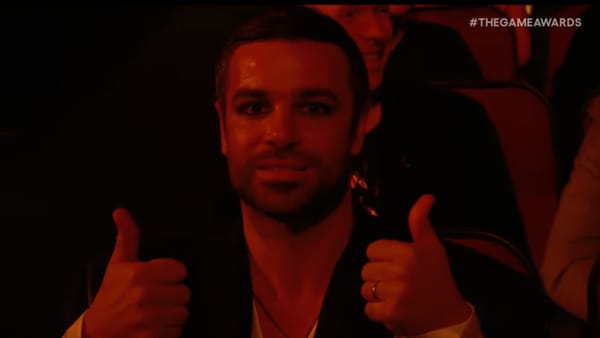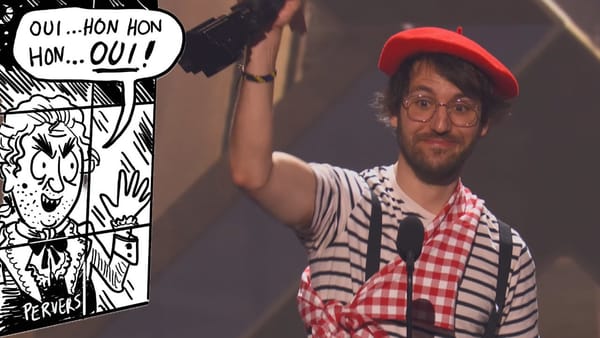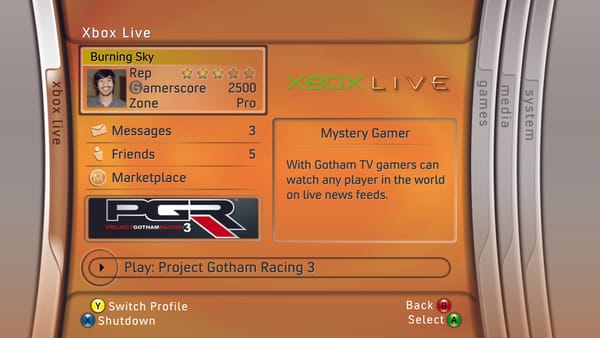#131: Hit Points plays the hot new videogame 'Street Fighter 6'
Spent two hours punching a PR guy in the face. Decent day.
Whenever I first sit down with a new Street Fighter — or, if I am honest, with any new fighting game — I have one vitally important question. Can I play this like Street Fighter II? That was the fighting game I fell in love with, the one that remains hardwired into my brain and will, I suspect, be there until my dying day. Whenever I play a new Street Fighter, or any new fighting game, I start by playing SFII and muddle things out from there. Luckily for me, most fighting games are designed that way too.
I bounced off Street Fighter V, for a number of reasons. I found its artstyle tremendously off-putting, cringing myself inside out every time one of the many titsy women in its cast bounced pendulously onto the screen. It arrived at a time in my life that was pretty incompatible with playing fighting games: I was too busy playing other stuff for work, my reactions and execution were increasingly ravaged by age, and the loud clack of an arcade stick in the small hours of the night was no good in a house shared with two small kids and a sleep-deprived wife.
My biggest problem with SFV, though, was that I couldn’t play it like Street Fighter II. It was a game, I felt, that simply tried too hard to be different. Stubby little normal attacks killed my ground game stone dead. Redesigned special moves, weird combo timings and a strange, uncomfortable flow to the action moved my comfort zone to another continent. Yes, it launched in a miserable state, with a terrible whisper of a tutorial and a singleplayer component so negligible it might as well not have been there at all, but my issues with it were more fundamental than that. It just never made sense to me, and it didn’t take long for me to stop trying to understand it.
Anyway, after driving to That London yesterday for a two-hour hands-on session at Capcom’s UK HQ, I am delighted to report that you can totally play Street Fighter 6 like SFII. Buttons do pretty much what you expect them to, and attacks connect from the sorts of ranges you expect. The decades-old bread-and-butter combos are all there, as well as some old favourites from SFIV et al. I am not quite saying that playing SF6 Ryu is like putting on a beloved, worn-in pair of slippers — there is far too much new in the game for that — but it certainly feels like replacing your old favourites with a new pair from the same place. I felt immediately at home.
Coverage of the game so far has either been by relative Street Fighter beginners, or high-level hardcore enthusiasts. I will try and look at it through the Hit Points lens, zooming out a bit for a broader view. As OG readers and IRL pals will know, I love fighting games, and Street Fighter in particular. I used to be quite handy at them. But as I have written in the past, I am also very frustrated with how unwelcoming the genre and its standard bearer are to newcomers. This is in part about tutorials, yes — something at which Street Fighter has been especially terrible over the years. Capcom seems to believe that, because it threw SFII into arcades with nothing more than a printed move list and watched as it turned into a global phenomenon, it can keep doing the same thing forever, with the same results. As far as the Street Fighter development team is concerned, onboarding is for boats.
But it is also a question of design. These games, like most supposedly hardcore videogame pursuits, are made for their existing audiences: that means pushing the skill ceiling ever higher with each new instalment, giving genre enthusiasts new ways to test themselves. Fighting-game developers build beautiful penthouses while their ground floors fall further and further into disrepair — and the only way up is a rope ladder that is covered in spikes and greased with blood. I’d love to tell you that with Street Fighter 6, Capcom is finally building an elevator, but I can’t say that after spending a couple of hours with a small demo (there are just four characters on offer, and I only play as three: Luke looks too much like he lives in a TikTok house for me to take seriously, though I am happy punching him in the face). It does look, however, as if Capcom has at least unlocked the building’s entrance, dismissed the burly doorman, and has at last begun to think about putting in some stairs.
The new systems seem to have been designed with both novices and battle-hardened grandmasters in mind. An optional simplified control scheme maps special moves to a single button, the specific move dictated by D-pad directions. There are just three attack buttons — light, medium and heavy — and holding one down in conjunction with the right trigger performs a quick auto-combo. Super moves, normally requiring a double quarter-circle joystick motion, merely ask for two face buttons and a D-pad direction.
The whole thing feels deeply weird to me, but as someone with hundreds of hours of arcade-stick practice in my locker, I suppose it should; they didn’t make it with me in mind. I muck about and string something together. A Chun Li auto-combo ends with the opponent in the air; I follow it with a jumping special, then a Super when I’m on the ground. That took, I think, six button presses and a bit of D-pad action. I’m not sure I could have done that one on a stick — not without a bit of practice, anyway. Good stuff.
Vitally, this doesn’t take anything away from the complexity of the game. The old wizards can still use their arcade sticks, still plunder the darkest corners of the battle system for all it is worth. They will be able to do longer combos that do more damage. But Modern controls make it slightly easier for less experienced players to jump in and start to suss the game out, without constantly cursing the fact that they can’t hit tricky combo timings, or reliably do a Shoryuken when facing left. This should also make it much easier for newcomers to move around the cast, rather than sticking with the only character they have a vague understanding of how to play — another timeworn problem with fighting games.
This is a bit of a theme for SF6, I think: making Street Fighter more welcoming to those on the ground floor, while still finding ways to both motivate and reward those who prefer life up in the rafters. A Capcom tweet earlier this week revealed that Guile’s Sonic Boom has a more powerful variant, with a flashier visual effect, if you perfectly time the move input. Excellent! Fiddling around with the new Drive moves, I learned that what I thought was a pretty straight lift of SFIII: Third Strike’s parry is in fact a lot broader, and a good deal friendlier. You can hold the buttons down and just keep soaking up attacks, providing you’ve got the Drive meter for it. If the opponent tries to cross you up (forgive the terminology: jumps over you to hit you in the back of the head, forcing you to block in the opposite direction) while you’re holding the parry buttons down, your character turns around automatically while still in the parry stance. Lovely stuff! But if you just tap the parry input at the precise moment an incoming blow connects, the effect is like Third Strike: a big juicy hit-pause, a flashy visual effect, and a yawning chasm of frame advantage for you to exact revenge on your assailant. Cor.
So, are you also starting to see a theme? Easy to do at low levels, better if you do it the hard way, and fairly obvious communication about what you have to do to get from the former to the latter. That’s very good, I think. I was very impressed. If Capcom pays a similar level of care and attention to the tutorial and the World Tour singleplayer mode — which is by no means guaranteed, of course — we could be looking at something pretty special.
So, good omens for genre novices. The battle-hardened Street Fighter community seems very excited about it all, too. For people in the middle like me? It’s probably too early to say, though I think the changes to the way meter works — your Drive gauge is full at the start of each round and refills automatically over time, rather than having you fill an empty bar by landing attacks, which has always inherently favoured the stronger player — in theory gives the likes of me a fighting chance against their superiors. We’ll see, I suppose. But regardless, the fact I was disappointed when my time was up, and left the Capcom building excited to play more, says a lot. I haven’t been excited about Street Fighter for years.
Haring down the M4 to make it back in time for nursery pickup, it suddenly occurred to me how much I had missed it. The kids are older now. I have a much better work/life balance. Perhaps there’s room in my life for arcade sticks again. For Street Fighter. That’d be nice.
I’m never playing Luke, obviously. What a prick.
(Thanks to Capcom UK and PR pal Ian Dickson for having me.)
MAILBAG!
- “I was caught fairly unawares by not-E3,” writes Andreia, who in her defence has only recently discovered Hit Points, “and accidentally stumbled upon the Summer Game Fest stream (and your delightful fashion commentary). What is the point of this thing? It's the same exact type of games that everyone else is showing, a multitude of triple-A trailers from the same usual publishers, with no real theme that sets it apart from all the other shows. They're talking about doing a live show next year, and I'm really very curious about what the pitch is.” I think ultimately it’s that Geoff Keighley is everywhere else, and so he might as well take over E3 as well. His format works well at Gamescom, where there is less competition for trailers and announcements. And it works at The Game Awards because that part of the calendar was effectively empty until he came along. But E3’s a different kettle of ball-games entirely, and I think we saw the challenge he faces in putting his stamp on not-E3 in last week’s show. There just aren’t enough of what I suppose we could call ‘Keighley games’ (ugh, sorry) to go around.
- “I’m very much with you in being massively sceptical of any claim around the potential of cloud technology in game design,” writes Ben in the Hit Points Discord, which I promise I will stop pimping at some point but it’s a very nice place so… not yet, sorry, still pimping. “I think the only real example we've had so far was, what, Crackdown 3's multiplayer? Did that even happen in the end? I don't think throwing [cloud tech] out there now counts for anything more than a tick on the buzzword bingo card.” It looks like Crackdown 3’s cloud stuff did happen, albeit dramatically scaled back from the original demo. As someone pointed out in the Discord (sorry!) Flight Simulator is the most striking demonstration of cloud technology that games have yet seen, but my suspicion about Kojima’s game is based on the assumption that it will build on the foundations of Death Stranding with some sort of collaborative multiplayer component, and I’m just not sure about that. Just as offline games are limited by the processing power of the weakest hardware they’re being made for, so cloud games will be held back by the need to account for the lowest possible bandwidth. I’m not saying it isn’t possible, but it does make the concept far less appealing, I think.
MORE!
- Not-E3 isn’t quite done with us yet. Capcom answered my prayers with a very brief announcement of Dragon’s Dogma II, and Square Enix unveiled Disc 2 of Final Fantasy VII Remake, subtitled Rebirth for some reason, which it says will arrive next winter.
- Todd Howard says Fallout 5 is next on deck for Bethesda after Starfield and The Elder Scrolls VI, but let’s not hold our breath: in the same interview he says TESVI is still in pre-production, which seems quite mad — troubling, you might say — for a game that was announced four years ago.
- Embracer CEO Lars Wingefors has defended the $1bn investment the company has received from Saudi Arabia’s Public Investment Fund. He’s on a hiding to nothing with this one really but fair play to him for addressing it at all.
- Activision Blizzard’s board of directors has cleared itself of any wrongdoing in an investigation of its historic role in the firm’s miserable culture of harassment and misconduct. Rest in peace, satire, you had a good run.
- Research has found that, unsurprisingly, working in VR is bad for productivity. This tracks with conversations I’ve had with a few people about the difficulty of making VR games, one of whom is the subject of the running-late next instalment of Max HP. Please look forward to it.
- I greatly enjoyed this GI.biz piece about where all the videogames have disappeared to. The story is far more nuanced than ‘lmao Covid’, though obviously that has played a part.
- Let us end the week with some fun, and look at photos of celebrities of yore playing videogames.
You’re all caught up! This has been a very long and tiring week, and next week is looking even longer and, erm, tiringer. Sorry, never been much good with words. As ever, if you’ve enjoyed this, do furiously mash the share button and spread the word! And remember that a paid subscription costs a little over 10p per day, and helps keep the lights on at Hit Points Towers — no mean feat with energy costs rising by the day. Have a grand weekend, whatever it has in store, and I’ll see you all next week.





